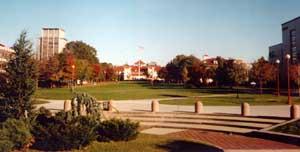| LCD Home | ||||||
Linguistics & Applied Linguistics
|
||||||
Communication Sciences & Disorders
|
||||||
Department of Linguistics & Communication Disorders
Division of Arts & Humanities
Queens College
City University of New York
65-30 Kissena Blvd.
Flushing, NY 11367-1597
Tel 718-997-2870
Fax 718-997-2873
http://www.qc.cuny.edu/LCD

SITEMAP:
[QC Home]
© Queens College Department of Linguistics and Communications Disorders. All rights Reserved.
To report any problems with this site, contact the Webmeister.
Undergraduate Major in General Linguistics
In this program students study the phonological, semantic, syntactic, and morphological aspects of language. They learn the linguistic, psycholinguistic, and sociolinguistic principles underlying language acquisition, especially the acquisition of languages beyond those learned in infancy and early childhood. They analyze the complexities in the structure and social use of languages both in monolingual and multilingual populations.
Students must file a Program of Study with an adviser.
Requirements for the Major
Satisfactory completion of the following 39 credits: LCD 101, 110, 116, 120, 130, 205, 209, 220, 306, 360; three elective courses, all of which must be approved by a departmental adviser. Note: No course will count toward this major with a grade lower than C-. (See additional LCD courses in the undergraduate bulletin and Gen Ed Courses.)
Course Descriptions
N.B. See adviser for the sequencing of courses and for a list of recommended electives.
LCD 101. Introduction to Language. 3 hr.; 3 cr. A survey of the study of language: Structure, language and society, first and second language acquisition, and other related topics. (Fulfills LASAR Humanities III requirement.)
LCD 110. Phonetics. 3 hr.; 3 cr. The nature of speech production; phonetic properties of language; practice in hearing, producing, and transcribing speech sounds.
LCD 116. The Structure of English Words. 3 hr.; 3 cr. The structure of English vocabulary; how words are formed; rules for determining the meaning, spelling, and pronunciation of English words.
LCD 120. The Syntactic Structure of English I. 3 hr.; 3 cr. The study of the structure of sentences in English, with implications for TESOL, Part I.
LCD 130. The Sound Structure of English. 3 hr.; 3 cr. The study of the articulation and patterning of sounds in English, with implications for TESOL.
LCD 205. Sociolinguistics. 3 hr.; 3 cr. Prereq.: LCD 101 or 104 or 105. Introduction to the study of the relationship between language and society. Socio-cultural factors which influence language form, use, and history. (Fulfills one of the LASAR requirements in the Social Sciences.)
LCD 209. Language and Mind. 3 hr.; 3 cr. Prereq.: LCD 101. Influential views in the acquisition of language; the relationship between language and thought; the relationship between language and culture/world view.
LCD 220. The Syntactic Structure of English II. 3 hr.; 3 cr. The study of the structure of sentences in English, with implications for TESOL, Part II. Continuation of LCD 120.
LCD 306. Semantics and Pragmatics. 3 hr.; 3 cr. Coreq./Prereq.: LCD 220. A survey of properties of meaning in language (semantics) and communication strategies people use when they talk to each other (pragmatics). There is a substantial writing commitment in this course.
LCD 360. Issues in Linguistic Research. 3 hr.; 3 cr. Prereq.: LCD 101. This course focuses on contemporary issues in any of the major branches of linguistics. May be repeated for credit when topics vary sufficiently. There is a substantial writing commitment in this course.